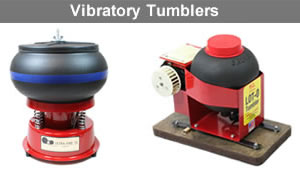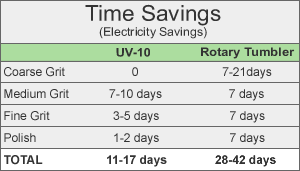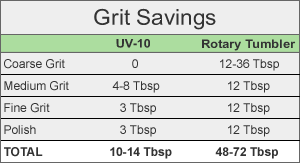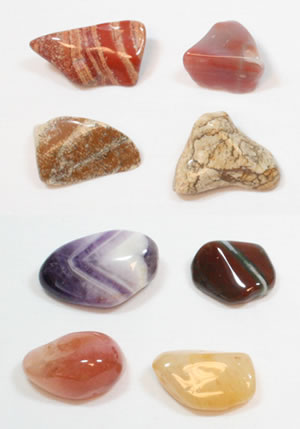Save Time and Money with a Vibratory Tumbler

Rocks in a vibratory tumbler are shaken at a rate of at least 3000 vibrations per minute. That rapid action quickly smooths the rocks during the grinding steps. During the polishing step the rocks are buffed to a very bright finish using a tiny amount of polish.
Save Time, Grit, Polish and Electricity
Vibratory tumblers can produce tumbled stones in less than 50% the time required for a rotary tumbler. That enables you to process more stones per month and spend less money on electricity per pound of rock processed. In addition, vibratory tumblers only require about 25% as much grit and polish compared to a rotary tumbler. That will save you a lot of money.
Other important differences between vibratory and rotary tumblers are the action that occurs in the barrel and the shape of the stones produced. Rotary machines rely mainly on the tumbling action to shape the stones, but vibratory machines have an action that rapidly rubs the stones together. The result can be seen in the shapes of the finished stones. Tumbled stones produced in a rotary machine have a more rounded shape (see photos at bottom right).
Rotary vs. Vibratory Tumblers
Rotary and vibratory tumblers are very different. A rotary tumbler has a barrel that rotates about 30 to 50 times per minute. The stones tumble in the barrel and are worn round and smooth by particles of very hard grit that get caught between them as they tumble. This action slowly rounds the stones and slowly grinds their surfaces smooth.
A vibratory tumbler has a bowl that shakes at over 3000 vibrations per minute. That shaking causes the stones to rapidly slide back and forth on one another with pieces of grit caught between them, which grinds their surfaces smooth. A minor tumbling action also develops in the bowl. This very rapid shaking is much more efficient at smoothing the surface of the rocks than the tumbling action in a rotary tumbler. The result is a significant time savings.

This chart compares the amount of time required to process rocks in the UV-10 rock tumbler to the time required to process a similar amount of rock in a rotary tumbler. The vibratory tumbler can complete the tumbling process in less than half the amount of time it takes a rotary tumbler. That will also be an electricity savings from running the tumbler a smaller number of days.
How Much Time is Saved?
Most people who use a rotary tumbler run the stones for seven days in coarse grit, seven days in medium grit, seven days in a fine grit and seven days in a polish. Those who are picky about producing really nice stones run the coarse grit step two, three or four times depending upon the shape and hardness of the rocks being tumbled. The total time spent on this rotary procedure is between four and seven weeks. (We usually run our rocks in coarse grit for two or four weeks depending upon the material. Soft materials like opal, obsidian or glass run for a few days per step, while very hard materials like Brazilian agate or Ohio flint might spend four weeks in coarse grit and one week in the remaining three steps. We are probably pickier than most about producing nicely-rounded rocks.)
With a vibratory tumbler, you begin with medium grit and the surfaces of the stones are quickly worn smooth because of the very fast vibrations. Many people who use vibratory tumblers run the medium grit step for seven to ten days depending upon the shape and hardness of the material being tumbled. The fine grit and polishing steps are much shorter, requiring just two or three days per step to complete. The time savings is summarized in the chart at right.

This chart compares the amount of grit used for a batch of rocks processed in the Thumler's UV-10 vibratory tumbler to the amount of grit used for a similar amount of rocks processed in a rotary tumbler. If you look at the totals, you will see that the rotary tumbler required over FOUR times as much grit. (Coarse grit is not used in vibratory tumblers.)
How Much Grit and Polish are Saved?
Vibratory tumblers require very little grit. All of the grit in a vibratory tumbler is sticking to the surface of the rocks. When the rocks rub together, cutting is done. In a rotary tumbler the grit is sloshing around in a slurry and only contacts the rocks momentarily. More grit is needed in a rotary tumbler because most of the time it is not in contact with the rocks.
In the typical rotary tumbler, you use about two ounces of grit or polish for each pound of rocks in the barrel. In the vibratory tumbler, just 1/2 ounce of grit (or less) is used per pound of rock. That is a savings of at least 75%!

Four brightly polished stones that were tumbled in a vibratory machine (top) and four that were tumbled in a rotary machine (bottom). The vibratory stones retained their original angular shape - their surfaces were smoothed and polished. Tumbling rocks in a rotary machine produces rocks with a more rounded shape.
The Shape Difference
The stones produced by vibratory and rotary tumbling have different shapes. The rolling action in a rotary tumbler knocks the edges off of the rocks to produce a rounded shape. The rubbing action in a vibratory tumbler does not make a great change in the shape of the rocks. A comparison of rotary and vibratory rocks is shown in the image at right.
Lots of people prefer the angular shape of rocks processed in a vibratory tumbler. However, many people (including us) have a very strong preference for rounded rocks. To accomplish that and still get a time savings, our rocks spend the coarse grit step in a rotary tumbler until they have the rounded shape that we are looking for. Then we save time and money by processing the medium, fine and polishing steps in a vibratory tumbler. That gives us the rounded shapes that we enjoy and the cost/time savings that we appreciate. And, the bonus is the slightly brighter polish that we seem to get in a vibratory tumbler.
Happy Tumbling!
RockTumbler.com Authors
 |
Hobart M. King has decades of rock tumbling experience and writes most of the articles on RockTumbler.com. He has a PhD in geology and is a GIA graduate gemologist. He also writes the articles about rocks, minerals and gems on Geology.com. |

